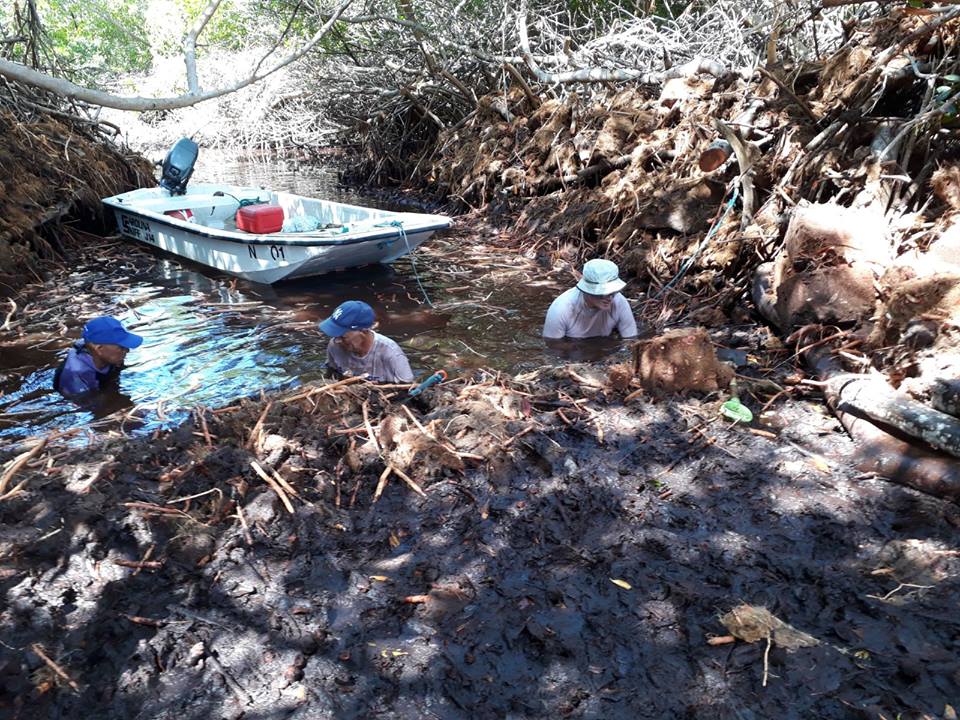Restoration of Lac Bay, Bonaire
Ecological Restoration Lac & South Coast Bonaire Nature Fund Project
Lac Bay, in the Caribbean island of Bonaire, is a crescent of water that is shallow, turquoise, and tranquil.
The mangrove forests that fringe its shores and creeks are essential for the reef fish, sea and shore birds, and seagrass fields that make Lac Bay an area of exceptional biodiversity. These mangroves are considered an internationally important area for wildlife, with all 780 hectares of the bay designated as a Ramsar wetland site.
But like many islands, tourism and other human activities are threatening the health of this coastal ecosystem. Increased sedimentation from upstream erosion chokes the bay, and tourism brings traffic and trash. For the mangroves, this means dangerously saline water and habitat destruction.
Mangrove-rich Lac Bay is designated as both a Ramsar site and Important Bird Area. (Credit: STINAPA)
The “Ecological Restoration Lac and South Coast Bonaire” (Eco-Restoration) project is on a mission to change the fate of the bay. For the mangroves, this will be both hydrological and ecological, with important behavior changes for visitors and upstream residents. The work in the mangrove area is managed by the nonprofit Stichting Nationale Parken Bonaire (STINAPA Bonaire), and the infrastructural aspects by the Policy and Projects Department of Bonaire. The project will run from 2015 – 2019. It is funded by the Netherlands Ministry of Economic Affairs through the Nature Fund.
Hydrological and Ecological Restoration
As sediment accumulates in Lac Bay, red mangroves begin to spread into the now shallow tidal creeks that diffuse critical fresh seawater throughout the mangrove forests. This blockage decreases water circulation by preventing fresh seawater from reaching the mangroves that are more inland, spiking the water salinity. This eventually harms the entire area of mangroves, stunting their growth and ultimately killing them.
Through Eco-Restoration, channels in the forests to the north and west of Lac are being reopened and mangrove trees are trimmed to improve water circulation. This will help decrease and stabilize water salinity, leading to healthier conditions for the mangroves. The effects of the restoration are closely monitored and assessed jointly with Dr. Dolfi Debrot, a tropical marine ecologist with Wageningen Marine Research.
But prevention of oversedimentation is key to staying ahead of the problem. Culverts and spill-over structures with sediment sinks have been constructed and improved along the road to Lac. This will help trap sediment before it reaches the bay. Eco-Restoration also combines its efforts with other Nature Fund projects in Bonaire; it has found particular synergy with the “Combating Erosion and Nature Restoration” project, which improves infrastructure that slows surface freshwater flow and reduces sediment runoff.

Volunteers and staff clearing the oversedimented creek channels from overgrown mangroves. (Credit: STINAPA)
Behavior Change
The beautiful beaches of Lac Bay are a draw for tourism, but this can have some harmful side effects for the mangroves.
When vehicular traffic strays onto the sensitive beaches it compacts the soil and destroys mangrove seeds and saplings. Eco-Restoration redirects cars from these areas by placing natural barriers, like rocks and boulders, around parking lots and beaches.
Pollution is also a major issue for the bay. Improved latrine facilities and rubbish infrastructure help to stem the amount of pollution entering the mangrove forests and bay.
Ultimately, outreach and education for tourists and locals are important in sustaining the restoration of Lac Bay. Informational signage has been installed around the bay and volunteers are invited to help with various hands-on projects.
Questions? Contact Sabine Engel (Mangrove Project Coordinator)